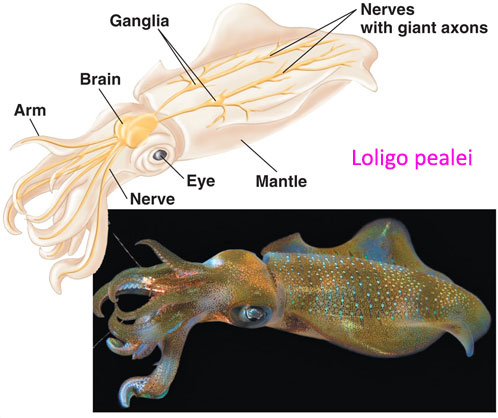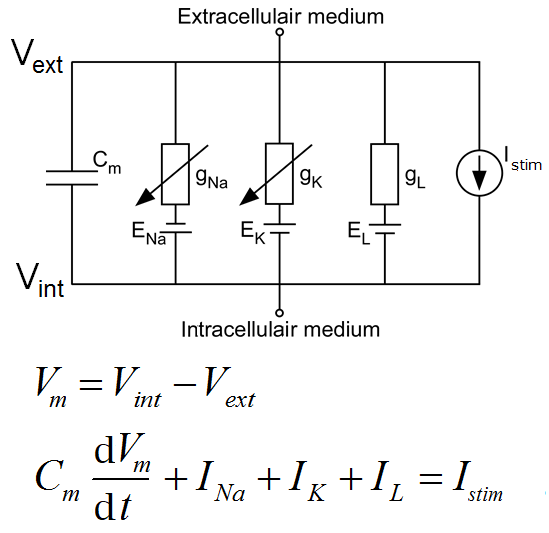Bioelectricity: Electric excitability and action potential
 The electric analogue of the model of Hodgkin and Huxley
The electric analogue of the model of Hodgkin and Huxley
Hodgkin and Huxley examined the conductivity of the membrane of a giant nerve fibre (giant axon) of a squid.

They included in their model only potassium and sodium channels, plus a leakage channel (mainly \(\mathrm{K}^{+}\) leakage) and used the following electric analogue:
 So far still not much new under the sun, and Hodgkin and Huxley used the following definition of the conductivity \(g_\mathrm{ion}\) of ion channel: \[I_\mathrm{ion}=g_\mathrm{ion}\cdot (V_m-E_\mathrm{ion})\] where \(I_\mathrm{ion}\) is the electric current through the ion channel caused by the electrochemical driving force created by the difference between the membrane potential \(V_m\) and the Nernst potential of the ion. But contrary to what we have assumed until now, the conductivity of an ion need not be constant. For the leak channel we assume a constant conductivity, but for potassium and sodium channels we choose a controllable conductivity., as a matter of fact a voltage-dependent conductivity. This is why an arrow is drawn through resistors in the electrical analogue; just an indication that the conductivity is not constant.
So far still not much new under the sun, and Hodgkin and Huxley used the following definition of the conductivity \(g_\mathrm{ion}\) of ion channel: \[I_\mathrm{ion}=g_\mathrm{ion}\cdot (V_m-E_\mathrm{ion})\] where \(I_\mathrm{ion}\) is the electric current through the ion channel caused by the electrochemical driving force created by the difference between the membrane potential \(V_m\) and the Nernst potential of the ion. But contrary to what we have assumed until now, the conductivity of an ion need not be constant. For the leak channel we assume a constant conductivity, but for potassium and sodium channels we choose a controllable conductivity., as a matter of fact a voltage-dependent conductivity. This is why an arrow is drawn through resistors in the electrical analogue; just an indication that the conductivity is not constant.
Hodgkin and Huxley investigated experimentally how the conductivity of sodium and potassium channels depends on the membrane voltage and change as a function of time. Using their measurements they proposed formulas that describe the conductivity of sodium and potassium channels as a function of voltage and time well, which means that the model results with measured results agree well with each other. Many of the assumptions that Hodgkin and Huxley made were later verified and supported by new experimental methods in their model. Hodgkin and Huxley in 1963 received the Nobel prize for their pioneering work.
From the model of Hodgkin and Huxley follows that the action potentials are induced by changes in the conductivity of potassium and sodium channels in the membrane. The leakage channel has a constant value in this model. In order to determine the conductivity of potassium and sodium channels they used two experimental techniques that were new at the time, namely, space-clamp and voltage-clamp techniques.


